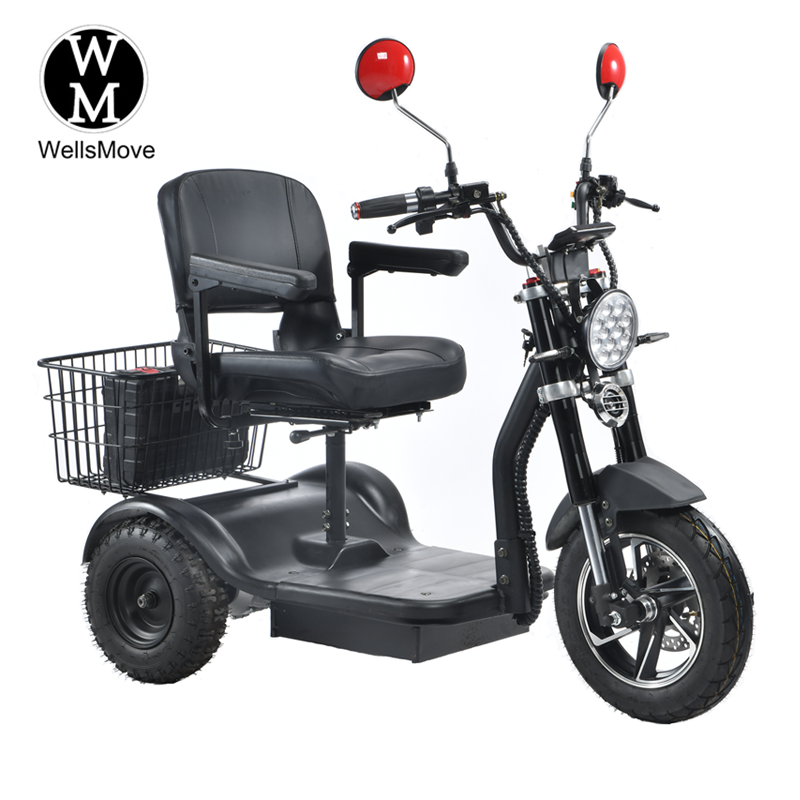A complete guide to the precautions for purchasing electric three-wheeled scooters for the elderly
Introduction
With the increasing aging of the global population, the market demand for electric three-wheeled scooters for the elderly is growing. For international wholesale buyers, it is crucial to choose the right supplier of electric three-wheeled scooters for the elderly. This article will elaborate on the precautions for purchasing electric three-wheeled scooters for the elderly from multiple aspects to help buyers make wise decisions.
1. Clarify product standards and regulations
Pay attention to regulatory differences in the target market: There are significant differences in regulatory requirements for electric three-wheeled scooters for the elderly in different countries and regions. For example, in some places, there are strict restrictions on the speed, weight, size, etc. of vehicles. Buyers must be familiar with and ensure that the purchased vehicles comply with all relevant regulations of the target market, otherwise they may face problems such as inability to sell or legal disputes.
Verify vehicle certification: Require suppliers to provide relevant quality certification certificates such as 3C certification and CE certification for vehicles. These certificates are important guarantees for product quality and safety performance. Uncertified vehicles may have safety hazards and cannot be legally sold in many markets.
2. Investigate the qualifications and reputation of suppliers
Evaluate the comprehensive strength of suppliers: Conduct on-site inspections of the supplier’s production scale, production capacity, R&D level, etc. Select suppliers with larger production scales and advanced production equipment, who can often ensure stable supply and quality control of products. At the same time, the supplier’s R&D capabilities are also related to product upgrades and technological innovations, which helps buyers maintain competitiveness in the market.
Understand the supplier’s reputation: Check the supplier’s historical transaction records, customer reviews, and industry reputation. You can communicate with existing customers and review relevant commercial credit assessment reports to understand whether the supplier delivers on time, whether the product quality is stable, and whether the after-sales service is in place. Good reputation is the basis for long-term cooperation. Avoid cooperating with suppliers with poor reputation to reduce procurement risks.
3. Pay attention to product quality and performance
Inspect the quality of key vehicle components: Focus on the quality of key components such as the vehicle’s motor, battery, controller, and brake system. High-quality motors should have the characteristics of high efficiency, low noise, and long life; the battery needs to have a high capacity and stability to ensure the vehicle’s cruising range and safety; the controller should ensure that the vehicle is stable and easy to operate; the braking system must be sensitive and reliable, and can brake in time in an emergency to ensure the safety of the elderly.
Test vehicle performance: Before purchasing, require suppliers to provide vehicles for actual testing. The test content includes the vehicle’s maximum speed, acceleration performance, climbing ability, turning flexibility, braking distance, etc. Through actual testing, you can more intuitively understand whether the vehicle’s performance meets the daily travel needs of the elderly, and its performance under different road conditions. For example, the vehicle’s driving stability on flat roads and ramps, and its flexibility when turning are all crucial.
4. Pay attention to product design and comfort
Ergonomic design: The design of the electric three-wheeled scooter for the elderly should fully consider ergonomic principles to ensure the comfort of the elderly. The height, width, backrest angle, etc. of the seat need to be reasonably designed to provide good waist and back support and reduce the fatigue of the elderly after long-term riding. At the same time, the location of the vehicle’s operating handles, pedals and other control components should also be convenient for the elderly to operate, in line with their physical activity range and habits.
Vehicle stability and safety design: The structural design of the tricycle should ensure the stability of the vehicle to avoid dangerous situations such as rollover during driving. For example, reasonable distribution of the center of gravity of the vehicle body and wide wheel spacing can help improve the stability of the vehicle. In addition, the vehicle should also be equipped with some safety protection devices, such as seat belts, anti-collision devices, rearview mirrors, etc., to enhance the travel safety of the elderly.
5. Consider after-sales service and support
Understand the after-sales service network: Ask the supplier whether it has established a complete after-sales service network in the target market, including the distribution of maintenance sites and the timeliness of spare parts supply. A convenient after-sales service network can ensure that the elderly can get timely repairs and solutions when they encounter problems during use, reducing the inconvenience and safety hazards caused by vehicle failures.
Clarify the terms of after-sales service: Negotiate with the supplier and clarify the specific terms of after-sales service, such as warranty period, warranty scope, and the way to bear the maintenance costs. Understand the supplier’s handling process and response time for product quality issues to ensure that an effective solution can be quickly obtained when the vehicle fails. At the same time, for maintenance services beyond the warranty scope, the relevant cost standards and maintenance policies should also be clarified to avoid disputes in the future.
6. Compare prices and costs
Comprehensively evaluate price factors: Price is one of the important considerations in the procurement process, but price should not be the only basis for decision-making. Comprehensively evaluate the relationship between the price and quality, performance, after-sales service, etc. of the vehicle to find the most cost-effective product. Compare the price differences of the same or similar products provided by different suppliers, and analyze the reasons behind their prices, such as production costs, brand value, profit margins, etc., to ensure that the purchased vehicles can meet quality and performance requirements while being reasonably priced.
Consider long-term costs: In addition to the purchase price of the vehicle, its long-term use costs should also be considered, including battery replacement costs, maintenance costs, energy consumption, etc. Although some vehicles have a low purchase price, short battery life, high maintenance costs, or low energy efficiency may result in high long-term use costs. Therefore, these factors should be comprehensively considered in procurement decisions to reduce the total cost over the entire use cycle.
7. Other considerations
Intellectual property issues: Ensure that there are no intellectual property disputes in the purchased electric three-wheeled scooters for the elderly. Avoid purchasing products that use other people’s patents, trademarks or designs without authorization to avoid legal problems and economic losses.
Cultural differences and market demand adaptability: Consider the cultural differences of the target market and the special requirements of the elderly’s usage habits for products. For example, the elderly in different regions may have different preferences for the color, appearance design, functional configuration and other aspects of the vehicle. Buyers need to choose marketable products based on the characteristics of market demand to improve the market acceptance and competitiveness of the products.
Logistics and transportation arrangements: Rationally plan logistics and transportation methods to ensure that the vehicles can be delivered to the target market safely and on time. Understand the packaging requirements, transportation size and weight of the vehicle, and choose the right transportation company and transportation route to reduce transportation costs and risks. At the same time, pay attention to the vehicle protection measures during transportation to prevent the vehicle from being damaged during transportation.
Conclusion
Purchasing electric three-wheeled scooters for the elderly is an important task that requires comprehensive consideration of multiple factors. Only when international wholesale buyers have clarified product standards and regulations, examined supplier qualifications and reputation, attached importance to product quality and performance, paid attention to product design and comfort, considered after-sales service and support, compared prices and costs, and paid attention to other relevant matters, can they choose high-quality, safe and reliable electric tricycles for the elderly, meet the needs of the target market and succeed in the highly competitive market. It is hoped that the purchasing considerations described in this article can provide valuable reference and guidance for international wholesale buyers of electric tricycles for the elderly, help them make wise purchasing decisions, and promote the healthy development of the electric tricycles for the elderly industry.
Post time: May-14-2025



